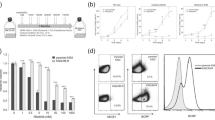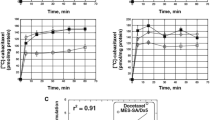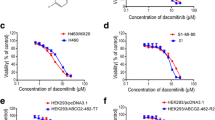Abstract
Purpose: Several studies have demonstrated significant interactions between immunosuppressants (e.g., cyclosporin A) and chemotherapeutic drugs that are BCRP substrates (e.g., irinotecan), resulting in increased bioavailability and reduced clearance of these agents. One possible mechanism underlying this observation is that the immunosuppressants modulate the pharmacokinetics of these drugs by inhibiting BCRP. Therefore, the aim of this study was to determine whether the immunosuppressants cyclosporin A, tacrolimus and sirolimus are inhibitors and/or substrates of BCRP. Methods: First, the effect of the immunosuppressants on BCRP efflux activity in BCRP-expressing HEK cells was measured by flow cytometry. Results: Cyclosporin A, tacrolimus and sirolimus significantly inhibited BCRP-mediated efflux of pheophorbide A, mitoxantrone and BODIPY-prazosin. The EC50 values of cyclosporin A, tacrolimus and sirolimus for inhibition of BCRP-mediated pheophorbide A efflux were 4.3±1.9 μM, 3.6±1.8 μM and 1.9±0.4 μM, respectively. Cyclosporin A, tacrolimus and sirolimus also effectively reversed resistance of HEK cells to topotecan and mitoxantrone conferred by BCRP. When direct efflux of cyclosporin A, tacrolimus and sirolimus was measured, these compounds were found not to be transported by BCRP. Consistent with this finding, BCRP did not confer resistance to the immunosuppressants in HEK cells. Conclusion: These results indicate that cyclosporin A, tacrolimus and sirolimus are effective inhibitors but not substrates of BCRP. These findings could explain the altered pharmacokinetics of BCRP substrate drugs when co-administered with the immunosuppressants and suggest that pharmacokinetic modulation by the immunosuppressants may improve the therapeutic outcome of these drugs.



Similar content being viewed by others
References
Allikmets R, Schriml LM, Hutchinson A, Romano-Spica V, Dean M (1998) A human placenta-specific ATP-binding cassette gene (ABCP) on chromosome 4q22 that is involved in multidrug resistance. Cancer Res 58:5337–5339
Benderra Z, Faussat AM, Sayada L, Perrot JY, Chaoui D, Marie JP, Legrand O (2004) Breast cancer resistance protein and P-glycoprotein in 149 adult acute myeloid leukemias. Clin Cancer Res 10:7896–7902
Breedveld P, Zelcer N, Pluim D, Sonmezer O, Tibben MM, Beijnen JH, Schinkel AH, van Tellingen O, Borst P, Schellens JH (2004) Mechanism of the pharmacokinetic interaction between methotrexate and benzimidazoles: potential role for breast cancer resistance protein in clinical drug–drug interactions. Cancer Res 64:5804–5811
Chester JD, Joel SP, Cheeseman SL, Hall GD, Braun MS, Perry J, Davis T, Button CJ, Seymour MT (2003) Phase I and pharmacokinetic study of intravenous irinotecan plus oral ciclosporin in patients with fuorouracil-refractory metastatic colon cancer. J Clin Oncol 21:1125–1132
Chu XY, Kato Y, Sugiyama Y (1999) Possible involvement of P-glycoprotein in biliary excretion of CPT-11 in rats. Drug Metab Dispos 27:440–441
Cisternino S, Mercier C, Bourasset F, Roux F, Scherrmann JM (2004) Expression, up-regulation, and transport activity of the multidrug-resistance protein abcg2 at the mouse blood–brain barrier. Cancer Res 64:3296–3301
Davies B, Morris T (1993) Physiological parameters in laboratory animals and humans. Pharm Res 10:1093–1095
Davit B, Reynolds K, Yuan R, Ajayi F, Conner D, Fadiran E, Gillespie B, Sahajwalla C, Huang SM, Lesko LJ (1999) FDA evaluations using in vitro metabolism to predict and interpret in vivo metabolic drug–drug interactions: impact on labeling. J Clin Pharmacol 39:899–910
Doyle LA, Ross DD, Sridhara R, Fojo AT, Kaufmann SH, Lee EJ, Schiffer CA (1995) Expression of a 95 kDa membrane protein is associated with low daunorubicin accumulation in leukaemic blast cells. Br J Cancer 71:52–58
Doyle LA, Yang W, Abruzzo LV, Krogmann T, Gao Y, Rishi AK, Ross DD (1998) A multidrug resistance transporter from human MCF-7 breast cancer cells. Proc Natl Acad Sci USA 95:15665–15670
Doyle LA, Ross DD (2003) Multidrug resistance mediated by the breast cancer resistance protein BCRP (ABCG2). Oncogene 22:7340–7358
Ejendal KF, Hrycyna CA (2005) Differential sensitivities of the human ATP-binding cassette transporters ABCG2 and P-glycoprotein to cyclosporin A. Mol Pharmacol 67:902–911
Garcia-Escarp M, Martinez-Munoz V, Sales-Pardo I, Barquinero J, Domingo JC, Marin P, Petriz J (2004) Flow cytometry-based approach to ABCG2 function suggests that the transporter differentially handles the influx and efflux of drugs. Cytometry A 62:129–138
Gornet JM, Lokiec F, Duclos-Vallee JC, Azoulay D, Goldwasser F (2001) Severe CPT-11-induced diarrhea in presence of FK-506 following liver transplantation for hepatocellular carcinoma. Anticancer Res 21:4203–4206
Gupta A, Zhang Y, Unadkat JD, Mao Q (2004) HIV protease inhibitors are inhibitors but not substrates of the human breast cancer resistance protein (BCRP/ABCG2). J Pharmacol Exp Ther 310:334–341
Gupta E, Mick R, Ramirez J, Wang X, Lestingi TM, Vokes EE, Ratain MJ (1997) Pharmacokinetic and pharmacodynamic evaluation of the topoisomerase inhibitor irinotecan in cancer patients. J Clin Oncol 15:1502–1510
Hirano M, Maeda K, Matsushima S, Nozaki Y, Kusuhara H, Sugiyama Y (2005) Involvement of BCRP (ABCG2) in the biliary excretion of pitavastatin. Mol Pharmacol 68:800–807
Innocenti F, Undevia SD, Ramirez J, Mani S, Schilsky RL, Vogelzang NJ, Prado M, Ratain MJ (2004) A phase I trial of pharmacologic modulation of irinotecan with cyclosporine and phenobarbital. Clin Pharmacol Ther 76:490–502
Jonker JW, Smit JW, Brinkhuis RF, Maliepaard M, Beijnen JH, Schellens JH, Schinkel AH (2000) Role of breast cancer resistance protein in the bioavailability and fetal penetration of topotecan. J Natl Cancer Inst 92:1651–1656
Jonker JW, Buitelaar M, Wagenaar E, Van Der Valk MA, Scheffer GL, Scheper RJ, Plosch T, Kuipers F, Elferink RP, Rosing H, Beijnen JH, Schinkel AH (2002) The breast cancer resistance protein protects against a major chlorophyll-derived dietary phototoxin and protoporphyria. Proc Natl Acad Sci USA 99:15649–15654
Kruijtzer CM, Beijnen JH, Rosing H, ten Bokkel Huinink WW, Schot M, Jewell RC, Paul EM, Schellens JH (2002) Increased oral bioavailability of topotecan in combination with the breast cancer resistance protein and P-glycoprotein inhibitor GF120918. J Clin Oncol 20:2943–2950
Lalloo AK, Luo FR, Guo A, Paranjpe PV, Lee SH, Vyas V, Rubin E, Sinko PJ (2004) Membrane transport of camptothecin: facilitation by human P-glycoprotein (ABCB1) and multidrug resistance protein 2 (ABCC2). BMC Med 2:16
Litman T, Brangi M, Hudson E, Fetsch P, Abati A, Ross DD, Miyake K, Resau JH, Bates SE (2000) The multidrug-resistant phenotype associated with overexpression of the new ABC half-transporter, MXR (ABCG2). J Cell Sci 113(Pt 11):2011–2021
Luo FR, Paranjpe PV, Guo A, Rubin E, Sinko P (2002) Intestinal transport of irinotecan in Caco-2 cells and MDCK II cells overexpressing efflux transporters Pgp, cMOAT, and MRP1. Drug Metab Dispos 30:763–770
Maliepaard M, Scheffer GL, Faneyte IF, van Gastelen MA, Pijnenborg AC, Schinkel AH, van De Vijver MJ, Scheper RJ, Schellens JH (2001) Subcellular localization and distribution of the breast cancer resistance protein transporter in normal human tissues. Cancer Res 61:3458–3464
Maliepaard M, van Gastelen MA, Tohgo A, Hausheer FH, van Waardenburg RC, de Jong LA, Pluim D, Beijnen JH, Schellens JH (2001) Circumvention of breast cancer resistance protein (BCRP)-mediated resistance to camptothecins in vitro using non-substrate drugs or the BCRP inhibitor GF120918. Clin Cancer Res 7:935–941
Mao Q, Conseil G, Gupta A, Cole SP, Unadkat JD (2004) Functional expression of the human breast cancer resistance protein in Pichia pastoris. Biochem Biophys Res Commun 320:730–737
Miyake K, Mickley L, Litman T, Zhan Z, Robey R, Cristensen B, Brangi M, Greenberger L, Dean M, Fojo T, Bates SE (1999) Molecular cloning of cDNAs which are highly overexpressed in mitoxantrone-resistant cells: demonstration of homology to ABC transport genes. Cancer Res 59:8–13
Nakatomi K, Yoshikawa M, Oka M, Ikegami Y, Hayasaka S, Sano K, Shiozawa K, Kawabata S, Soda H, Ishikawa T, Tanabe S, Kohno S (2001) Transport of 7-ethyl-10-hydroxycamptothecin (SN-38) by breast cancer resistance protein ABCG2 in human lung cancer cells. Biochem Biophys Res Commun 288:827–832
Ozvegy C, Litman T, Szakacs G, Nagy Z, Bates S, Varadi A, Sarkadi B (2001) Functional characterization of the human multidrug transporter, ABCG2, expressed in insect cells. Biochem Biophys Res Commun 285:111–117
Qadir M, O’Loughlin KL, Fricke SM, Williamson NA, Greco WR, Minderman H, Baer MR (2005) Cyclosporin A is a broad-spectrum multidrug resistance modulator. Clin Cancer Res 11:2320–2326
Rabindran SK, He H, Singh M, Brown E, Collins KI, Annable T, Greenberger LM (1998) Reversal of a novel multidrug resistance mechanism in human colon carcinoma cells by fumitremorgin C. Cancer Res 58:5850–5858
Robey RW, Honjo Y, van de Laar A, Miyake K, Regis JT, Litman T, Bates SE (2001) A functional assay for detection of the mitoxantrone resistance protein, MXR (ABCG2). Biochim Biophys Acta 1512:171–182
Robey RW, Honjo Y, Morisaki K, Nadjem TA, Runge S, Risbood M, Poruchynsky MS, Bates SE (2003) Mutations at amino-acid 482 in the ABCG2 gene affect substrate and antagonist specificity. Br J Cancer 89:1971–1978
Robey RW, Steadman K, Polgar O, Morisaki K, Blayney M, Mistry P, Bates SE (2004) Pheophorbide a is a specific probe for ABCG2 function and inhibition. Cancer Res 64:1242–1246
Sandborn WJ, Lawson GM, Krom RA, Wiesner RH (1992) Hepatic allograft cyclosporine concentration is independent of the route of cyclosporine administration and correlates with the occurrence of early cellular rejection. Hepatology 15:1086–1091
Scott LJ, Curran MP, Figgitt DP (2004) Rosuvastatin: a review of its use in the management of dyslipidemia. Am J Cardiovasc Drugs 4:117–138
Simonson SG, Raza A, Martin PD, Mitchell PD, Jarcho JA, Brown CD, Windass AS, Schneck DW (2004) Rosuvastatin pharmacokinetics in heart transplant recipients administered an antirejection regimen including cyclosporine. Clin Pharmacol Ther 76:167–177
Slatter JG, Schaaf LJ, Sams JP, Feenstra KL, Johnson MG, Bombardt PA, Cathcart KS, Verburg MT, Pearson LK, Compton LD, Miller LL, Baker DS, Pesheck CV, Lord RS 3rd (2000) Pharmacokinetics, metabolism, and excretion of irinotecan (CPT-11) following I.V. infusion of [(14)C]CPT-11 in cancer patients. Drug Metab Dispos 28:423–433
Takara K, Sakaeda T, Yagami T, Kobayashi H, Ohmoto N, Horinouchi M, Nishiguchi K, Okumura K (2002) Cytotoxic effects of 27 anticancer drugs in HeLa and MDR1-overexpressing derivative cell lines. Biol Pharm Bull 25:771–778
Taylor PJ (2004) Therapeutic drug monitoring of immunosuppressant drugs by high-performance liquid chromatography-mass spectrometry. Ther Drug Monit 26:215–219
Thummel KE, Shen DD (2001) Design and optimization of dosage regimens: pharmacokinetic data. In: Hardman JG, Limbird LE, Gilman AG (eds) Goodman & Gilman’s the pharmacological basis of therapeutics, 10th edn. McGraw-Hill, New York, pp 1917–2023
van Herwaarden AE, Jonker JW, Wagenaar E, Brinkhuis RF, Schellens JH, Beijnen JH, Schinkel AH (2003) The breast cancer resistance protein (Bcrp1/Abcg2) restricts exposure to the dietary carcinogen 2-amino-1-methyl-6-phenylimidazo[4,5-b]pyridine. Cancer Res 63:6447–6452
Vethanayagam RR, Wang H, Gupta A, Zhang Y, Lewis F, Unadkat JD, Mao Q (2005) Functional analysis of the human variants of BCRP: I206L, N590Y, and D620N. Drug Metab Dispos 33:697–705
Wang EJ, Casciano CN, Clement RP, Johnson WW (2000) In vitro flow cytometry method to quantitatively assess inhibitors of P-glycoprotein. Drug Metab Dispos 28:522–528
Yoh K, Ishii G, Yokose T, Minegishi Y, Tsuta K, Goto K, Nishiwaki Y, Kodama T, Suga M, Ochiai A (2004) Breast cancer resistance protein impacts clinical outcome in platinum-based chemotherapy for advanced non-small cell lung cancer. Clin Cancer Res 10:1691–1697
Acknowledgements
The authors thank Drs. Robert W. Robey and Susan E. Bates (National Cancer Institute, Bethesda, MD) for providing the HEK cell lines and FTC. We also acknowledge GlaxoSmithKline for providing topotecan.
Author information
Authors and Affiliations
Corresponding author
Additional information
Grant support: We gratefully acknowledge financial support from NIH grant HD044404 (to QM and JDU) and VA Merit Review grant (to DDR)
Rights and permissions
About this article
Cite this article
Gupta, A., Dai, Y., Vethanayagam, R.R. et al. Cyclosporin A, tacrolimus and sirolimus are potent inhibitors of the human breast cancer resistance protein (ABCG2) and reverse resistance to mitoxantrone and topotecan. Cancer Chemother Pharmacol 58, 374–383 (2006). https://doi.org/10.1007/s00280-005-0173-6
Received:
Accepted:
Published:
Issue Date:
DOI: https://doi.org/10.1007/s00280-005-0173-6




